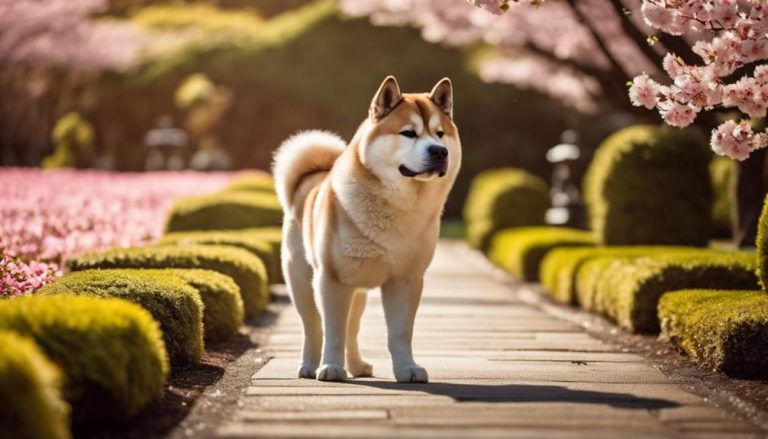Akita Inu: Japanese Canine Royalty
The Akita Inu is a remarkable dog breed from Japan, known for its powerful build, quick reflexes, and ability to withstand tough conditions. This breed has a robust muscular frame covered by a thick coat that protects it against harsh weather. Typically, they weigh between 55-130 pounds based on their gender, showcasing a majestic and proud look. They have a rich history, having once worked alongside samurai warriors.
Owners should be aware of specific health issues like hip dysplasia, which requires consistent check-ups with a vet. Akitas have a lifespan of about 10-15 years, emphasizing the need for proper care including a balanced diet, regular exercise, grooming, and socializing from a young age. Understanding and meeting their needs can forge a strong bond of loyalty between the dog and its owner.
Key Takeaways
- Japanese Akita Inus are loyal, strong, and calm.
- Grooming needs are high; they shed a lot.
- They’re natural protectors, once samurai companions.
Quick Facts
The Akita Inu is a proud large breed from Japan, known for its strong build, lush double coat, and a long lifespan of 10-15 years. These qualities highlight the breed’s overall good health and resilience.
As members of the Working Group, Akita Inus possess a unique combination of strength, agility, and stamina, making them perfect for their traditional roles in hunting and protection. Their dense coat, which comes in both short and long varieties, acts as a shield against extreme weather, showcasing their adaptability to different surroundings. However, this coat does need regular grooming to keep it in prime condition and to control shedding.
Regarding health, the Akita Inu’s genetic background makes it prone to specific conditions like hip dysplasia, which is common in larger dogs. It’s crucial for both potential and current owners to schedule regular vet visits to catch and manage these issues early on. Being proactive about your dog’s health is key to ensuring they lead a happy and healthy life.
Overview
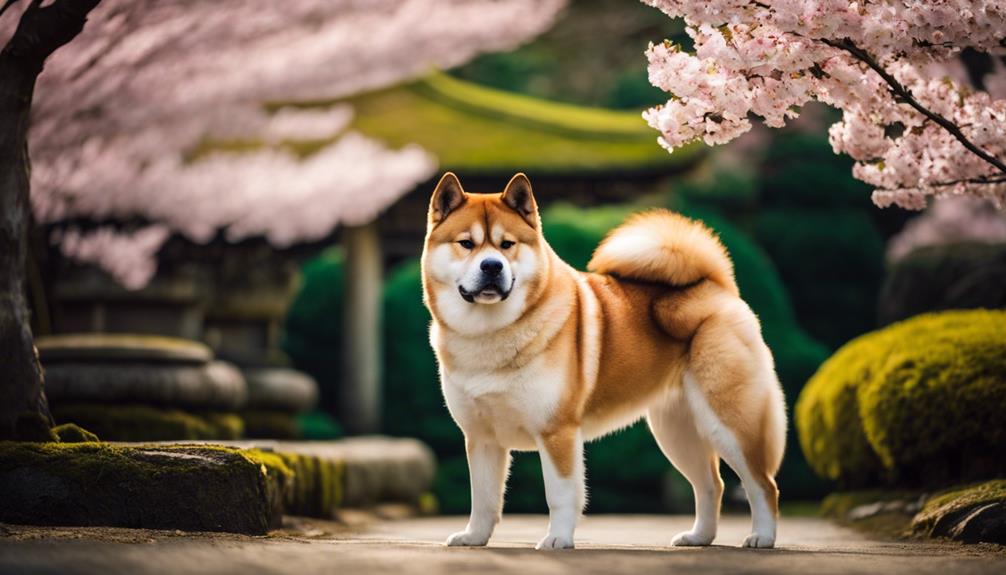
Knowing about the Akita Inu is crucial for anyone thinking of getting one or those who already have this breed. Hailing from Japan, this large-sized dog is famous for its loyalty and bravery, along with a regal way of carrying itself. Males can weigh between 60-130 pounds, while females range from 55-100 pounds. This variation in size means owners need to pay close attention to their pet’s diet and exercise to avoid obesity and ensure the dog stays healthy.
The Akita Inu has a dense double coat that comes in various colors. This coat needs regular brushing to keep shedding under control and the skin healthy. Such grooming practices are essential for the breed’s overall well-being. With an average lifespan of about 10 years, it’s important for potential owners to think about the long-term commitment of having an Akita Inu. Their impressive size and unique looks demand understanding from their owners about the space and physical activity these dogs require.
For those with Akita Inus, it’s important to keep up with regular vet visits. This ensures the dogs are not only healthy but also happy, given their specific health needs tied to their genetics. Owners should be well-informed and proactive in the care of their Akita Inus to provide a fulfilling life for these noble dogs.
Noble Samurai Companion
The Akita Inu, originally bred for guarding and assisting samurai warriors in Japan, embodies courage and loyalty. These traits make them outstanding protectors of the family. Historically, they were not just companions to samurai but also served as efficient guard dogs. Today, they excel in this role thanks to their noble and dignified presence, coupled with a strong build, which naturally commands respect and acts as a deterrent to possible threats.
| Trait | Description | Relevance to Samurai Companion |
|---|---|---|
| Size | Large and powerful | Well-suited for protection and guarding tasks |
| Temperament | Noble, dignified, and loyal | Mirrors samurai values of loyalty and honor |
| Physicality | Unique head and feet | Signs of strength and agility |
| Coat | Thick, in varied colors | Adaptable to Japan’s diverse climates |
| Training | Needs early socialization and training | Key for controlling their strong personality |
The Akita’s distinctive traits make them more than pets; they are loyal companions that remind us of their historical role alongside samurai. Their strong character and cautious attitude towards strangers underline the importance of experienced handling and consistent training. Proper training ensures their protective instincts benefit the family, keeping everyone safe.
Samurai Origins
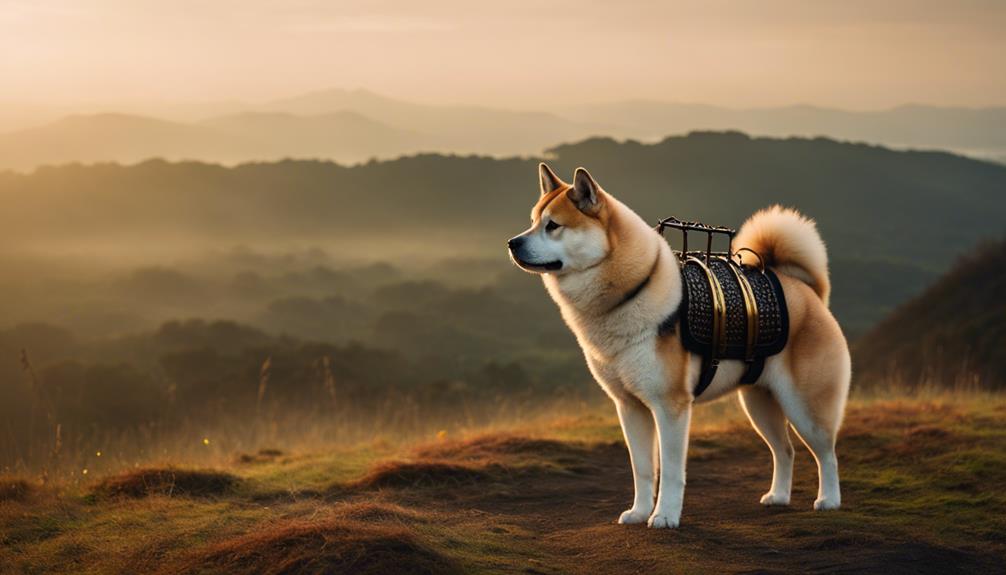
The Akita Inu has a rich history tied to Japan’s samurai culture. These dogs were not only fierce allies in battle but also loyal protectors at home. Their journey from being esteemed companions of the samurai to becoming a cherished part of Japan’s national heritage highlights their significance and the careful attention given to their breeding. We’ll look into the Akita Inu’s origins with the samurai, focusing on its development, historical impact, and lasting influence.
Warrior Partners of Old
The Akita Inu stood by the side of samurai warriors, ready to face any challenge. These dogs were more than pets; they were trusted members of the samurai’s lifestyle, demonstrating both bravery and loyalty.
Evolving with Time
The breed’s development over the years showcases a dedication to preserving its qualities. Breeders have worked hard to maintain the Akita Inu’s physical and temperamental traits that made them invaluable to samurai.
A Symbol of Culture
The Akita Inu holds a special place in Japanese culture. It represents much more than a dog breed; it’s a living symbol of loyalty, honor, and the rich history of Japan.
Careful Breeding
Selective breeding practices have ensured that the Akita Inu remains true to its historical roots. Breeders have focused on traits like courage, loyalty, and physical strength, which were essential for their roles alongside the samurai.
National Treasure
In recognition of its unique place in history and culture, the Akita Inu has been designated as a Japanese Natural Monument. This status highlights the breed’s importance and the commitment to preserving its legacy for future generations.
Through understanding the Akita Inu’s connection with the samurai, we appreciate not just the breed itself, but also a vital part of Japan’s heritage. This dog embodies the spirit and values that have been revered in Japanese culture for centuries.
Ancient Warrior Companions
In ancient Japan, the Akita Inu dogs held a prestigious position alongside samurai warriors, serving as both defenders and fighters. These dogs came from the Ōdate area and were first known for their role as guard dogs. Their loyalty and strength made them perfect for this job. The Akita’s ancestors, like the Matagi dogs from the Tōhoku region, played a big part in making the breed bigger and better at guarding and fighting. This change showed how adaptable and strong these dogs were, qualities that the samurai highly valued.
In 1931, recognizing their value and history, Akitas were named a Japanese natural monument. This honor made sure their place in Japan’s history was remembered.
Breed Development History
The Akita Inu breed has a storied past that intertwines with Japan’s history, evolving from their initial role as guards for the samurai. These dogs hail from the Ōdate region and were bred to be both large and capable, meeting the needs of their protective duties.
Over time, through careful breeding practices, their size and abilities were enhanced to better serve in guarding and even in warfare situations, such as during the Russo-Japanese War and World War II. This careful development not only established the Akita Inu as a powerful guardian breed but also led to their acknowledgment as a symbol of Japanese heritage, being declared a natural monument in 1931.
This recognition reflects their significant impact and lasting presence in Japanese culture and beyond.
Cultural Significance
The Akita Inu dogs are deeply rooted in Japan’s history, tracing their origins back to the samurai era where they served as both protectors and companions. Initially bred in the Ōdate region, these dogs were highly regarded by samurai and farmers alike, symbolizing loyalty, courage, and strength. Over time, they developed into larger and more imposing figures, perfectly suited for their protective roles.
In 1931, their significant cultural and historical value was officially recognized when they were declared a Japanese natural monument. Throughout challenging times, including the Russo-Japanese War and World War II, Akita Inus demonstrated exceptional bravery and loyalty. This not only solidified their reputation as more than just a dog breed but also as a cherished symbol of Japanese culture and heritage.
Large Breed
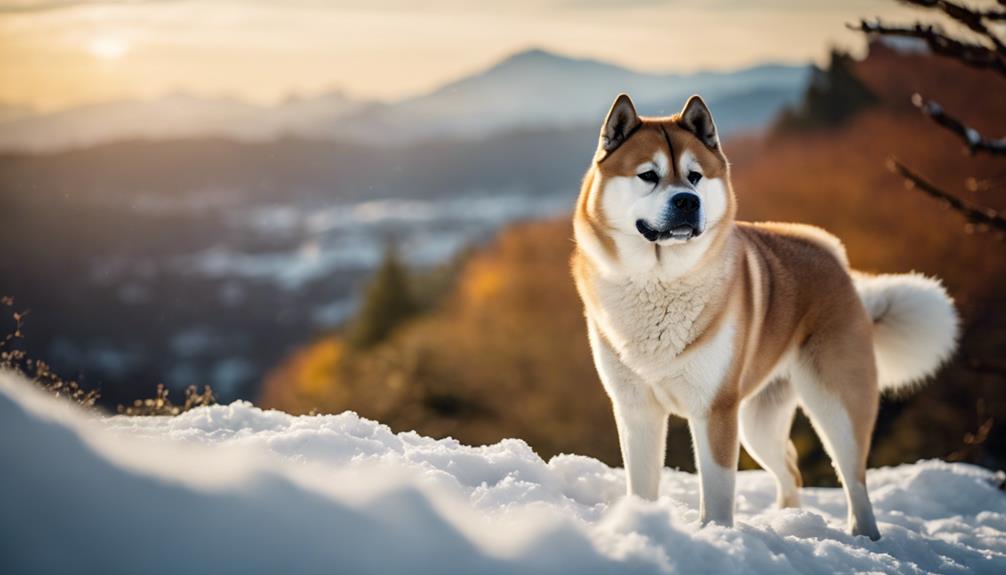
Owning an Akita Inu, due to their large breed nature, comes with its set of unique features and care demands that are crucial for owners to grasp. Their significant size and rapid growth call for a committed attitude towards their health and how they fit into a household. Catering to the Akita Inu’s specific requirements fosters a smooth and affectionate bond between the dog and its family.
- Size and Growth: It’s vital to keep an eye on their strong growth from when they are puppies until they reach full size.
- Temperament Traits: It helps to know about their independent and protective personality to ensure they socialize well.
- Health Concerns: Being aware of and averting illnesses common to the breed is key to keeping them healthy.
- Grooming Needs: They require regular grooming to keep their dense double coat in good condition.
- Training Challenges: Effective training involves being consistent and patient to make the most of their smart and loyal nature.
Understanding the Akita Inu’s characteristics and necessities leads to a positive and loving relationship with these remarkable dogs.
Size and Growth
Akitas are large dogs known for their strong build, weighing between 60-130 pounds for males and 55-100 pounds for females. They have a striking look with a head shaped like a bear’s and feet like a cat’s, making them look powerful and regal. Males stand 26-28 inches tall and females 24-26 inches, making them quite the presence.
One key feature of the Akita is their thick double coat, which requires regular grooming to stay healthy and look good. This coat can be various colors, adding to their visual appeal. Considering their size, Akitas need plenty of room and a secure place to live well. It’s vital to make sure you have the right space for them before bringing an Akita into your home.
Temperament Traits
Akita Inu dogs are loyal companions known for their protective nature and a bit of a cautious attitude towards strangers. They need early socialization to fit well into family life. These dogs are brave and have a strong instinct to guard, qualities that originally made them great for dog fighting. Now, they’ve moved past those days, but they still require an owner who knows what they’re doing. Akitas are physically strong and have bold personalities, which can be a lot for first-time dog owners to handle.
Training and socializing them properly is crucial to make the most of their loyalty and protective traits, ensuring they become valued family members. They have complex personalities that demand understanding and respect for their specific needs in a home setting.
Health Concerns
Akita Inus, known for their impressive size, may face health challenges like eye disorders and hip dysplasia due to their genetics. It’s crucial for those thinking about breeding these dogs to get their eyes and hips checked to help reduce the risk of these issues.
A healthy lifestyle for an Akita includes one to two hours of exercise daily and a diet that supports their nutritional needs, helping prevent stomach problems.
Having access to a spacious, secure garden is important for their physical and mental well-being. Taking steps like these helps manage health problems inherent to the breed, leading to a happier and healthier life for Akita Inus.
Grooming Needs
To keep their thick, double-layered fur in top shape, Akita Inus need to be groomed regularly, around two to three times weekly. Their large size means more fur, and thus, more attention to grooming is necessary to avoid tangles and to keep their coat healthy.
Using a metal, double-toothed comb is especially useful during their heavy shedding periods. This careful grooming routine helps avoid fur mats and keeps their coat looking great.
Shedding is a natural part of an Akita’s life, so regular grooming helps reduce the amount of fur that ends up around your home. These grooming moments are also perfect for checking the Akita’s skin for any problems, pests, or oddities. Catching these issues early on is key to ensuring your dog stays healthy.
Grooming isn’t just about making your Akita look good; it’s about keeping them healthy and comfortable.
Training Challenges
Training Akitas can be tough because of their large size, strong personality, and breed-specific traits. This dog breed needs experienced handling and a lot of socialization from a young age to do well. Akitas have a strong sense of territory and might act cautious around new people, making training a bit tricky. They also have a high prey drive, so it’s crucial to work on their ability to come back when called and to manage them carefully during training.
While Akitas might not find standard obedience training very exciting, they can excel in agility and other specialized activities. It’s important to closely supervise them around kids or other pets due to their independent and sometimes aloof nature. Training this breed means finding a balance between respecting their independence and encouraging a willingness to cooperate.
Loyal and Courageous
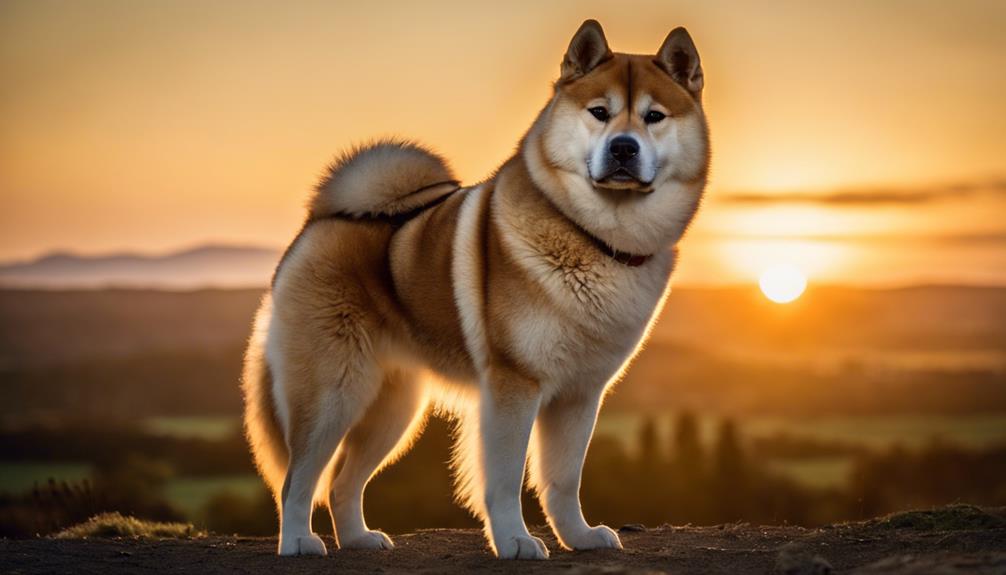
The Akita Inu stands out not just for its size but also for its loyal and brave nature, traits that trace back to its history with samurai and farmers. These dogs show a mix of protective behavior and steadfast friendship, making it crucial to understand them well for effective training. It’s important to meet their health and behavior needs in a way that’s tailored to this breed. Doing so helps bring out their natural protective instincts while keeping them healthy.
Understanding the Akita Inu’s background and characteristics is key to providing them with the right care and training. This approach ensures that their loyalty and bravery are nurtured in a positive way.
Origins of Loyalty
The Akita Inu breed stands out for its unmatched loyalty and courage, shaped by their history of serving as protectors for both samurai and farmers, as well as their involvement in battles. These dogs hail from the Ōdate area in Japan and have a long tradition of being reliable guardians, a characteristic that’s part of their nature. In 1931, their status as a symbol of national pride was cemented when they were declared a Japanese natural monument, highlighting their importance and the respect they command for their bravery.
Coming from a background that includes the strong Matagi dogs of the Tōhoku region, Akitas have developed unique physical and personality traits that make them excellent protectors. Their roles in significant historical events, including the Russo-Japanese War and World War II, have further established their reputation as faithful and brave companions. This history explains why Akitas are so revered and considered more than just pets in Japan and around the world.
Courageous Acts
Akitas are known for their loyalty and courage, traits that have made them famous as protectors. These dogs naturally protect their families, showing a strong sense of duty.
Originally bred as guard dogs, Akitas have proven time and again that they are dependable guardians. Their fearlessness and loyalty make them perfect for anyone looking for a brave and faithful dog.
The Akita Inu is especially celebrated for these qualities, making them great family and work dogs.
Training Challenges
Akitas are known for their loyalty and bravery, but these traits can make training a bit of a challenge. They need someone who knows what they’re doing and can handle their strong personality. Because they can be a bit territorial and not always friendly to strangers, it’s really important to start training them early. This helps make sure they grow up to be well-behaved and can handle different situations well.
Owners really need to get to know the Akita breed to train them the right way. Starting socialization early and using smart training strategies can help avoid any standoffish behavior. This way, an Akita can become a friendly and reliable companion. It’s all about building a strong bond through respect and understanding.
Protective Instincts
Akitas are known for their strong protective instinct, demonstrating their dedication and bravery in protecting their families and homes. This breed has a deep-rooted history as guard and combat dogs, which explains their natural inclination to guard their loved ones.
Akitas show an exceptional level of loyalty to their family, coupled with a boldness in facing potential dangers to their home or loved ones. With the right mix of temperament and physical strength, Akitas excel as watchdogs and protectors. Their protective behavior stems from their genetic background and historical roles, making them always alert and prepared to stand up for their family.
The blend of loyalty and bravery in Akitas sets them apart, ensuring they are constantly watchful and ready to act in defense of those they care about. This breed’s commitment to safeguarding their territory and family members showcases why they are highly valued as protective companions.
Companionship Qualities
In the world of dog breeds, the Akita Inu is highly regarded for its deep-seated loyalty and bravery. These dogs have a rich history as both guards and fighters, which has shaped their protective and courageous nature. Akitas are known for creating strong, lasting connections with their families, showcasing their role as reliable protectors and loving companions. Their bravery isn’t just for show; it’s been developed over centuries, preparing them to stand fearlessly in defense of their families.
The Akita Inu is celebrated in Japanese culture for representing health, happiness, and a long life. These attributes connect closely with their noble behavior and steadfast loyalty. The unique combination of loyalty and bravery makes the Akita Inu a perfect partner, embodying the true spirit of both a guardian and a valued family member. This breed’s qualities ensure that they are not just pets, but integral members of the family, offering protection and companionship.
Lifespan Concerns
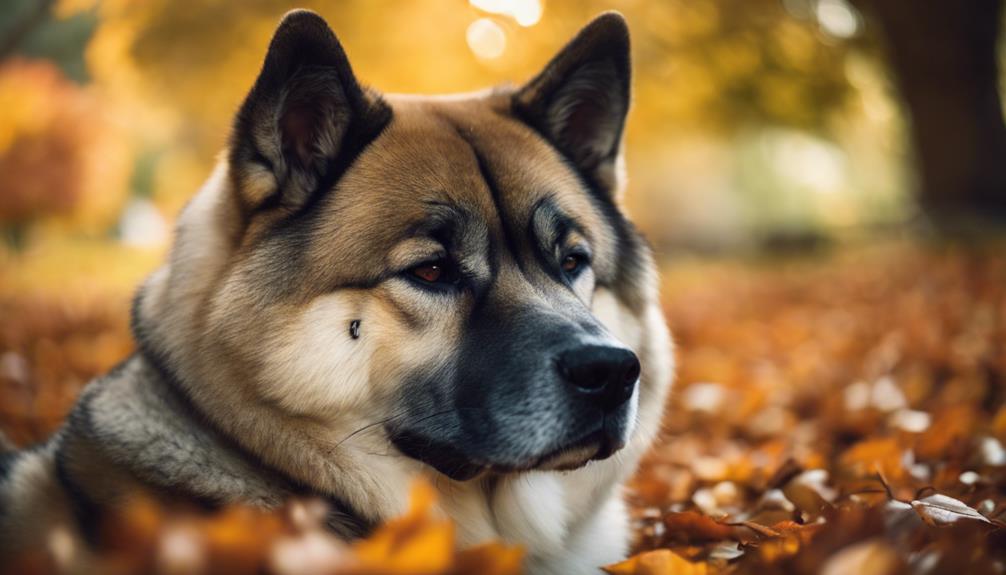
The Akita Inu is a breed admired for its loyalty and strength, usually living between 10 to 14 years. The length of their lives can be greatly affected by their health, which highlights the need for proper care. To ensure they live a full life, it’s crucial to adopt a comprehensive care plan that covers their diet, regular vet visits, and ethical breeding.
- Lifespan Expectations
- Influences on Health
- Tips for a Longer Life
- Ethical Breeding
- Genetic Health Checks
Akita Inus need a balanced diet, routine health care, and genetic screenings to address any inheritable conditions early. This approach not only helps in extending their lives but also improves their quality of life. Ethical breeding practices are equally important, as they prevent the propagation of genetic diseases.
Regular check-ups with a veterinarian and a diet tailored to their specific needs can make a big difference in their health. Incorporating regular exercise into their routine also keeps them fit and can ward off obesity-related issues. When it comes to breeding, choosing responsible breeders who conduct thorough health screenings can help ensure the puppies are healthy and have a better chance at a long life.
Average Lifespan Range
Akita Inus generally live between 10 and 14 years, but their lifespan can be shorter due to health issues. It’s essential for owners to be proactive with their care to help them live longer. Proper diet, regular veterinary visits, and monitoring for health conditions can make a big difference.
The breed is prone to autoimmune diseases and genetic conditions, which can affect their longevity. Catching and managing these issues early can help ensure a healthier life for Akita Inus.
Health Impact Factors
Knowing the health factors that can affect the lifespan of Akita Inus is crucial for their care. These dogs can live between 10 to 15 years, but their health and longevity are heavily influenced by genetic conditions. The most common issues are eye disorders and hip dysplasia, which can severely impact their well-being. It’s important for breeders to conduct eye exams and hip evaluations to reduce these problems in future generations.
For Akita owners, sticking to a strict health routine is key. This includes regular exercise, a well-balanced diet, and consistent grooming. These steps are vital in lowering the risk of health issues and ensuring a long, healthy life for Akita Inus. Keeping up with these practices makes a big difference in the quality of life for these dogs.
Extending Life Tips
Akita Inus can enjoy a longer lifespan with the right health practices. Regular vet visits and a balanced diet are crucial for spotting and addressing health issues early on. It’s important to keep these dogs at a healthy weight and provide them with the right nutrients to prevent obesity. A mix of physical exercise and brain games keeps them active and sharp, which is key for a long life.
Creating a stress-free living space and keeping up with their dental hygiene, grooming, and preventing parasites are all vital steps in boosting their overall well-being and longevity. Owners can significantly influence their Akita Inus’ life expectancy by focusing on these specific health measures, ensuring these dogs have a well-rounded diet and comprehensive care.
Grooming Needs
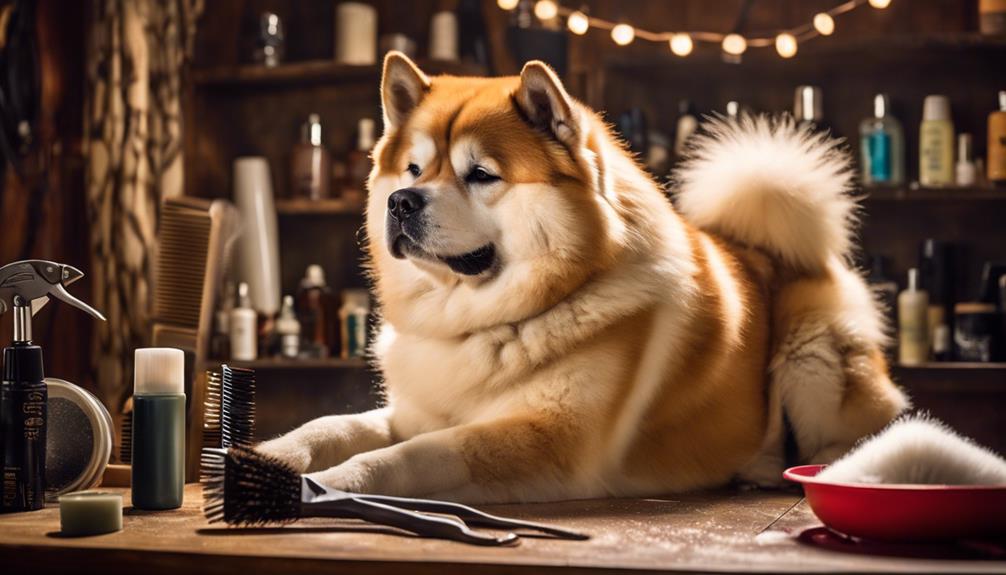
Taking care of an Akita Inu’s thick double coat is key to keeping them healthy and looking great. Regular grooming stops skin problems and boosts their overall health. It’s essential to stick to a grooming plan that fits their coat type.
Coat Care Must-Haves
To keep an Akita Inu’s coat in top shape, you need the right tools. A slicker brush, a metal comb, and a de-shedding tool are your go-tos. Using these helps remove tangles and dead fur, keeping the coat smooth and shiny.
How Often to Brush
Brushing your Akita Inu several times a week is a good rule. This breed sheds a lot, especially during spring and fall. During these times, you might need to brush them daily to manage the shedding.
Bathing Tips
Akitas don’t need baths too often—every few months should do, unless they get really dirty. Use a dog shampoo that’s gentle on their skin to keep their coat healthy and avoid drying it out.
Nail and Paw Upkeep
Don’t forget about the nails and paws. Trim their nails regularly to prevent discomfort and potential health issues. Checking and cleaning their paws can prevent infections, especially between the toes.
Advice for Different Seasons
Grooming changes with the seasons. In warmer months, more frequent brushing helps remove excess fur, keeping your Akita cooler. When it’s cold, focus on keeping their skin moisturized to prevent dryness.
Taking these steps ensures your Akita Inu stays comfortable and healthy year-round. It’s not just about looks; it’s about their well-being.
Coat Maintenance Essentials
Caring for an Akita Inu’s coat is a task that requires regular attention, involving brushing their dense coat two to three times a week. This routine is vital to prevent their fur from tangling and matting. During the times they shed the most, a metal comb with two sets of teeth is your best tool for removing loose hair and keeping their coat in top condition.
These grooming sessions do more than just keep the Akita Inu looking good. They help spread the dog’s natural skin oils throughout their coat, which supports healthier skin and reduces the amount of hair they shed. Since Akitas are known for shedding in certain seasons, sticking to a consistent grooming schedule is key.
Taking these steps to care for your Akita Inu’s coat not only keeps them looking great but also supports their overall health. It’s a straightforward way to ensure your dog feels as good as they look, highlighting the importance of grooming in their care.
Brushing Frequency Guidelines
To keep an Akita Inu’s thick coat in good shape, it’s best to brush it about two to three times every week. You might need to brush more often when they’re shedding a lot to keep their fur looking nice. Brushing this often helps avoid knots and reduces hair everywhere since their coats are so dense.
These grooming sessions are more than just about looks; they’re crucial for the Akita’s health. They help spread the dog’s natural skin oils, giving their coat a healthy shine. For even better results, using a metal, double-toothed comb can really help. It gets rid of dead hair and stops tangles, making sure your Akita’s coat stays in great condition and supports their health.
Bath Time Recommendations
When discussing the care of an Akita Inu’s thick fur, it’s crucial to consider how often they need baths. Typically, bathing this breed every 2 to 3 months works well, unless they get very dirty from outdoor activities. Using a high-quality dog shampoo designed for double-coated breeds is key. This type of shampoo cleans their coat effectively without removing the natural oils that keep their skin healthy and their fur shiny.
After bathing, it’s important to dry their coat thoroughly. Pay special attention to their thick undercoat to prevent any skin problems. Regular brushing sessions are also necessary. Brushing helps remove loose fur and prevents tangles, keeping the Akita Inu’s coat in good condition between baths.
Nail and Paw Care
Trimming your Akita’s nails regularly is crucial to prevent them from growing too long, which can cause pain and make it hard for your dog to walk. This should be a routine part of your dog’s grooming to keep them healthy and happy.
Paw care is just as important as nail trimming. You should check your dog’s paws often for any cuts, injuries, or objects stuck between their toes, as these can affect their ability to move and cause discomfort. In addition, to keep your Akita’s paw pads from getting dry and cracking, especially in extreme weather, applying moisturizer might be necessary.
Including these steps in your grooming routine helps catch any problems early, ensuring your dog stays in good shape and can move around comfortably.
Seasonal Grooming Tips
As seasons change, Akitas need more grooming to keep their thick, dual-layered coats in shape. When they start shedding heavily, brushing them more often is key to managing their fur. It helps prevent their hair from tangling and reduces the amount of fur around the house. Bathing should be kept to a minimum to avoid stripping away the natural oils that protect their skin. However, it’s still important to trim the fur around their ears, feet, and lower body to keep them clean and prevent infections.
During the heavy shedding period, it might be a good idea to get help from a professional groomer. They can make sure your Akita’s coat stays healthy, reducing the risk of skin problems. This approach not only keeps your dog looking good but also supports their overall well-being throughout the different seasons.
Dietary Requirements
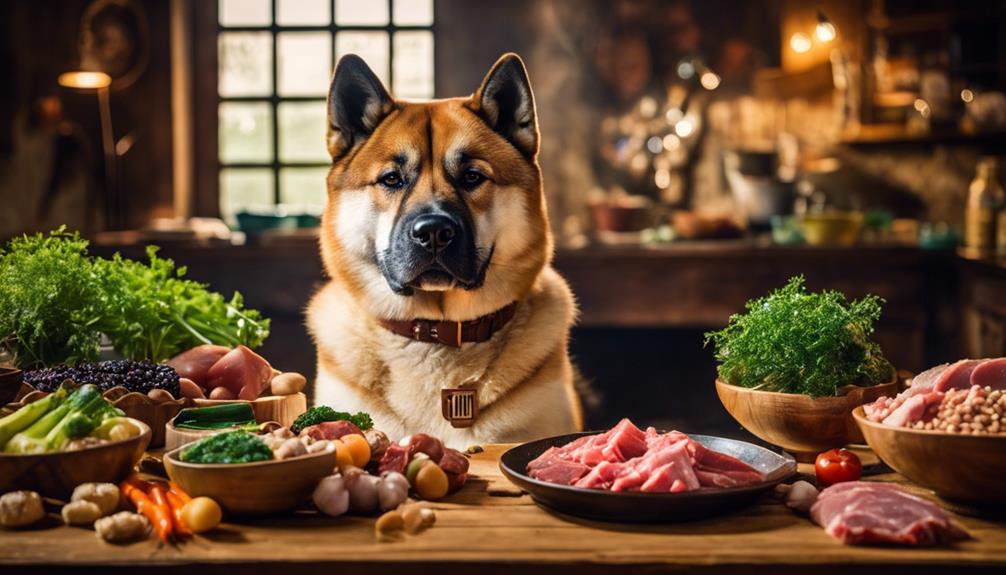
Understanding the dietary needs of an Akita Inu is crucial for their health and happiness. They have specific nutritional requirements and could be prone to food allergies, which makes finding the right diet vital. Creating a feeding routine that fits these needs not only keeps them healthy but also improves their life quality.
Nutritional Needs Analysis involves figuring out the perfect mix of proteins, fats, and carbs. High-quality protein is key for keeping their muscles strong and their energy up. Knowing what food allergies they might have helps in avoiding foods that could cause them problems. An optimal feeding schedule is important for their digestive health and to prevent issues like bloating. Keeping an eye on their weight is essential too, as being overweight can lead to health issues.
In short, paying attention to what and when your Akita eats is fundamental. This approach ensures they stay in top shape and lead a joyful life.
Nutritional Needs Analysis
Akitas, known for their strong build, need a diet rich in high-quality protein to keep their muscles healthy and ensure their general health is at its best. The American Kennel Club points out that due to their large size and thick fur, Akitas have special dietary needs that support their energy levels.
It’s important to manage their food intake carefully to avoid obesity, a common issue in larger dog breeds. They must have essential fatty acids in their diet to keep their skin and coat in good condition. Since Akitas can have stomach problems and are at risk of bloating, giving them smaller meals throughout the day is a good idea.
Keeping an eye on their weight and overall body condition helps make sure they’re eating enough but not too much, meeting their unique health requirements.
Common Food Allergies
Food allergies in Akita Inus can lead to uncomfortable symptoms such as itching, rashes, and digestive problems. To help these dogs, it’s key to avoid giving them foods that commonly cause allergies like wheat, corn, soy, and dairy. These allergies can seriously affect a dog’s health and happiness, making it crucial to get them on the right diet.
A good diet for an Akita Inu with food allergies might include meals with fewer ingredients or those that use unusual protein sources, like venison or duck. Getting advice from a vet is crucial to correctly identify what’s causing the allergies and to work out a diet that avoids these triggers. Keeping track of what your dog eats and trying out different foods one at a time can also help find out what causes their allergies. This approach ensures the dog gets a diet that keeps them healthy and allergy-free.
Ideal Feeding Schedule
Creating a healthy feeding schedule for Akita Inus is key to their well-being, as they need a diet packed with quality proteins and fats due to their large size and high energy levels. For these big breeds, splitting their food intake into two meals a day helps prevent bloating and aids in smoother digestion, which is also beneficial for instilling discipline through a regular routine. Puppies, still growing, should eat 3-4 times daily. It’s important to avoid overfeeding to dodge obesity, which can lead to joint problems and other health issues. Getting advice from a vet or dog nutrition expert can help customize the feeding plan for your Akita, making sure their diet is well-rounded for their health and happiness.
To maintain their health, sticking to a feeding routine that includes meals twice a day is advisable for adult Akitas, while younger dogs require more frequent feedings. This approach not only supports their physical needs but also establishes a daily structure, beneficial for their overall training and discipline. Overeating is a risk that should be carefully managed to avoid weight-related health complications. Consulting with a professional ensures that your Akita’s dietary needs are specifically met, promoting a balanced and healthy lifestyle.
Frequently Asked Questions
Are Akita Inus Good Family Dogs?
- Akita Inus bond deeply, making great family pets.
- Training and socializing early are key for their behavior.
- Their protective nature requires careful handling due to size.
Do Akita Inu Bark a Lot?
- Akita Inus bark less with good training.
- They react mostly to threats.
- Training reduces unnecessary barking.
Why Is Akita Inu so Expensive?
- Breeding challenges make them pricey.
- Rarity increases their value.
- Costs ensure quality care and health.
What Two Dogs Make an Akita?
- The Akita is a mix of Matagi and Tosa Inu dogs.
- This combination creates unique, health-focused features.
- Origin debates reflect the Akita’s rich history.

